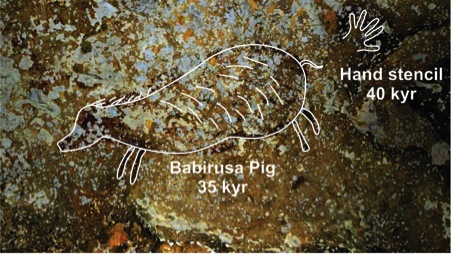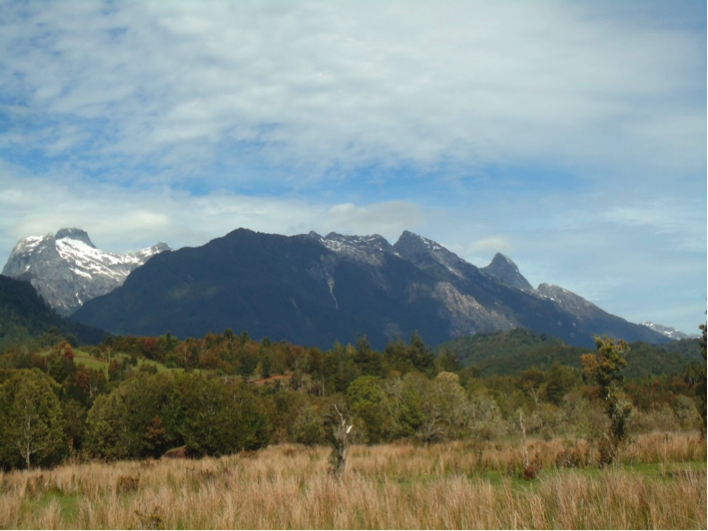By Ignacio Jara
Saying goodbye to 2014 and welcoming in 2015 is a good time to reflect. Apart from being the hottest year ever recorded, 2014 has passed really fast; with so many good research articles!
Since good science always keeps my spirits high, I have decided to embark on the tricky task of recapping some of the 2014 papers I have found most interesting, innovative or insightful. And yes, let me clarify in advance that this is my “personal choice”, so I take full responsibility for the choices and I’m sure that others have their own selection.
First I have to mention that 2014 was a year with some great archaeological research. Aubert et al. (2014) published a remarkable dating analysis of small speleothems in association with rock art from Sulawesi, Indonesia (Image 1). This work pushes the dates of the aboriginal rock art tradition in Southeast Asia back as far as 40 kyr ago. Apart from positioning the Sulawesi rock painting among the oldest symbolic art in the world and providing the oldest evidence for humans on the island, their results suggest that rock painting was a cultural trait that accompanied the first human population that ventured beyond the African continent, thus challenging the long-standing notion that animal painting was a relatively late form of art originating in Europe.

Following in the archaeological line, I do not want to miss the opportunity to mention the large amounts of archaeological research coming from China. Here, the research focus has been on studying past human-climate interactions by linking archaeological evidence with the growing number of well-dated high-resolution climate proxy data available from this region. Wang et al. (2014) produced a compilation of thousands of radiocarbon dates from multiple archaeological sites scattered all over China. This article provides a detailed human population reconstruction that covers the last 50 kyr, but also shows interesting correlations with long-term changes in monsoonal activity and high-latitude temperature . The evidence suggests that periods of warm/moist conditions are associated with peaks in Chinese population; whereas the cold/dry conditions experienced during the Heinrich events and the Younger Dryas seem to match declines in human population. Moreover, the past demographic changes revealed by their reconstruction show that the greatest population expansion in China’s prehistory took place at about 9 kyr ago, coeval with the onset of agricultural practices. Although still preliminary, the finding of a succession of shorter-term warm/cold phases observed during the middle and late Holocene suggests fascinating links with the complex cultural evolution observed between the Yellow and the Yangtze Rivers, the formative area of the classic Chinese civilisation.
Volcanic eruptions are well known to produce changes in climate conditions at annual or even decadal scales. However, a paper published late last year –back in 2013, but it is a pretty nice article- turns this notion on its head and provides convincing evidence of orbitally-forced variability in Quaternary volcanism (Kutterolf et al., 2013). The study performed a statistical analysis on a time series of volcanic eruptions obtained from tephra layers deposited in marine sediment cores around the Pacific “Ring of Fire”. The results of this analysis show a statistically robust frequency peak in global volcanism at 41 kyr, the Milankovitch obliquity frequency. The authors use the benthic foraminifera oxygen isotope stack as a proxy for changes in global ice volume to link orbitally-induced variations in ice-sheet extent to volcanic activity. Peaks in volcanic activity lag the deglaciation by about 4 kyr. Volcanic eruptions are more frequent when the ice-sheets retreat, when there is a reduction in the continental surface pressure. Several millennia of sustained deglaciation seem to be the precondition to not only decrease pressure over continental areas, but also to increase loading on the ocean the result of higher sea level resulting from the melting of ice sheets. According to the authors, this mass reorganization might be associated with the migrations of magma material from the oceanic plates towards the continents, which might ultimately result in a rise in onshore volcanic activity.
Continuing with the theme of ice-melting and ocean loading, a new detailed record of Antarctic ice discharge and modelling study provide interesting clues about the interactions between Antarctic ice sheet and ocean temperatures during the last deglaciation (Weber et al., 2014; Golledge et al. 2014). The first of these publications presents a highly-resolved reconstruction based on the accumulation of iceberg-rafted debris in two ocean records located to the northwest of the Antarctic Peninsula, a region known as the “Iceberg Alley” since it is the area through which icebergs from all parts of Antarctica abandon the continent and enter into the Southern Ocean. The record exhibits a series of well-defined centennial-scale peaks in iceberg debris between 20 and 9 kyr ago, suggesting the existences of several rapid pulses of ice loss during the Last Termination. The record also reveals that these episodes of enhanced iceberg movement started abruptly, quickly releasing fresh water into the Southern Ocean and contributing to global sea level rises. The melt water pulses cooled down the surface of the Southern Ocean, and ice-ocean modelling analysis shows that this same pulses might have produced more ice melting, as the release of melt water was also associated with an increase in the transport of warm deep waters from the Atlantic Ocean, which caused the intermediate and deep waters of the ocean to warm, which upwell around Antarctica and further accelerate the thinning of ice masses by basal melting. Interestingly, very similar results are obtained from the ice sheet, sea level and ocean temperatures modelling work presented in the second of these publications.
There is growing interest amongst paleoclimate researcher to reconstruct the past history of climate modes. Two new high-resolution reconstructions of the Southern Annular Mode (SAM) have been developed. Firstly, a composite SAM reconstruction based on proxies from mainland Antarctica, Antarctic Peninsula and South America was published early this year by Abram et al. (2014), which sets the recent trend in theSAM variation within the context of the last millennium. This paper also looks at the interaction of the SAM with climate variations in the tropical latitudes (see blog #9 for more details). Then more recently, a SAM reconstruction based on changes in vegetation and fire history from Patagonia (Moreno et al., 2014). In this article the present-day strong relationship between the Patagonian climate and the SAM is used to infer centennial-scale positive/negative phases of this climate mode over the last 3,000 years. Notably, positive SAM phases detected in this reconstruction broadly match the timing of the Industrial revolution, the Medieval Climate Anomaly, the Roman and the Bronze Age warm periods; while the negative SAM matches the Little Ice Age, the Dark Ages and the Iron Age Cold Period. Since all of these “climate ages” have been originally described in the Northern Hemisphere, their results point out to a continuous and rapid inter-hemispheric link at timescales of centuries.

Overall 2014 has been a great year for Quaternary Sciences. A broad range of good Quaternary science has been published. I hope you have enjoyed this compilation. What is coming up in 2015? Well, I am surely not a seer, but I hope to discuss some of the new research in more depth in the AQUA blogs and, hopefully, there will be some unexpected new discoveries that will get us out of our Quaternary comfort zone. Have a great new year!
References
Abram, N.J., Mulvaney, R., Vimeux, F., Phipps, S.J., Turner, J., England, M.H., 2014. Evolution of the Southern Annular Mode during the past millennium. Nature Clim. Change 4, 564-569.
Aubert, M., Brumm, A., Ramli, M., Sutikna, T., Saptomo, E.W., Hakim, B., Morwood, M.J., van den Bergh, G.D., Kinsley, L., Dosseto, A., 2014. Pleistocene cave art from Sulawesi, Indonesia. Nature 514, 223-227.
Golledge, N.R., Menviel, L., Carter, L., Fogwill, C.J., England, M.H., Cortese, G., Levy, R.H., 2014. Antarctic contribution to meltwater pulse 1A from reduced Southern Ocean overturning. Nat Commun 5.
Kutterolf, S., Jegen, M., Mitrovica, J.X., Kwasnitschka, T., Freundt, A., Huybers, P.J., 2012. A detection of Milankovitch frequencies in global volcanic activity. Geology.
Moreno, P.I., Vilanova, I., Villa-Martínez, R., Garreaud, R.D., Rojas, M., De Pol-Holz, R., 2014. Southern Annular Mode-like changes in southwestern Patagonia at centennial timescales over the last three millennia. Nat Commun 5.
Wang, C., Lu, H., Zhang, J., Gu, Z., He, K., 2014. Prehistoric demographic fluctuations in China inferred from radiocarbon data and their linkage with climate change over the past 50,000 years. Quaternary Science Reviews 98, 45-59.
Weber, M.E., Clark, P.U., Kuhn, G., Timmermann, A., Sprenk, D., Gladstone, R., Zhang, X., Lohmann, G., Menviel, L., Chikamoto, M.O., Friedrich, T., Ohlwein, C., 2014. Millennial-scale variability in Antarctic ice-sheet discharge during the last deglaciation. Nature 510, 134-138.